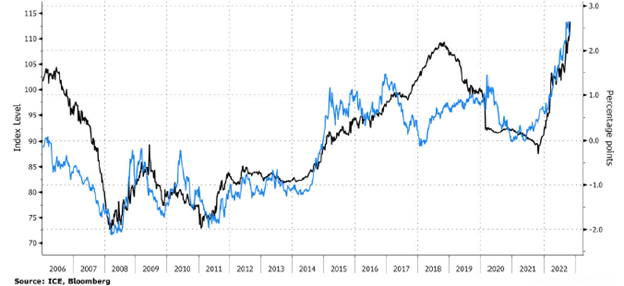
Validus appoints Gianluca Lorenzon as Head of Fund Finance Advisory in London
3 November 2022
Going it alone: central banks and the dawning of divergence
14 November 2022INSIGHTS • 8 NOVEMBER 2022
What’s next for the Fed? Look to the 1980s.

Ali Jaffari, Head of North American Capital Markets
Last week’s highly anticipated Fed meeting came and went with little fanfare as the committee reiterated its objective of lowering inflation back to its target 2% level. The market focus was largely on the outlook for the December meeting, where either a 50 or 75bps hike is anticipated. Key changes to note coming out of the meeting relate to i) expect longer than the initially anticipated cycle of rate increases to get inflation under control and ii) the lag of monetary policy decisions on economic activity and inflation will be considered to determine the continued pace of hikes. While providing some clarity in the near-term, a bout of uncertainty still remains beyond the next two committee meetings. Let’s delve into what this translates to on a go forward basis and the key risks to consider.
Back to the 80s
Since March this year, we’ve seen a total of 375 bps of rate hikes from the Fed, marking the most aggressive tightening cycle since the 1980s. To date, however, inflationary pressures remain elevated and although we are seeing shift in the inflation composition, i.e., from goods to services, the overall basket remains well above the Fed’s target. Hence, Jerome Powell’s remarks on the need to be “sufficiently restrictive” with the indication of continued hikes comes as no surprise. However, it does raise a question on where the terminal level of rates needs to be – one that will largely be driven by labor market and inflation data releases in the coming months.
Powell’s acknowledgement of the lag in monetary policy on economic activity sent a dovish signal to the market and paved the way for a 50bps hike at the next December meeting, deviating from the recent four 75bps hikes. This certainly creates more flexibility for the Fed in managing future hikes, while remaining committed to its inflationary goal. It’s reasonable to expect a lag from central bank’s policy on economic activity, but at this point it’s still unclear what the ‘right’ periodicity is.
If you look back to high inflation in the early 1980s, albeit a different economic environment as whole, the Fed’s swift and aggressive policy stance saw an outsized decline in inflation figures within a year. You can argue that given the high degree of leverage consumers and households have now versus the 1980s, that the sensitivity to higher interest rates now should be more profound. However, juxtapose that with the make up of the inflationary profile today, price pressures as it relates services may not be as responsive to Fed hikes. The upcoming data and the committee’s response to it will be critical in assessing the next economic cycle.
Whether the above plays out and rates persist at elevated levels for an extended period or not, if inflation remains sticky, central banks will have to move faster and perhaps wean markets off their meticulous forward guidance. Recency bias is hard to overcome, and it is tempting to assume rates won’t move too much higher from here, but this needn’t be the case. If your business or investment works with rates where they are today, there’s an increasingly compelling argument to take rates risk, and the incoming volatility, off the table as we march toward a period of economic fragility.
Three Key Scenarios
Here are a few scenarios to think through:
- Inflation data is responsive and the Fed does an actual pivot to put the brakes on its hiking cycle This is the Fed’s desired outcome. If the lagged effect of monetary policy does indeed manifest itself in inflation data over the coming months, we could potentially see a halt in the hiking cycle. Expect a reversal in the dollar, and a stabilization of rates volatility with near longer-term rates trending lower.
- Inflation remains high, and the Fed continues with its tightening cycle As global central banks prepare to slow the pace of tightening amidst growing concerns of a deeper recession, the Fed remains committed to its goal. Alongside the Fed last week, the BoE announced a 75bps hike, however as a stark contrast, the BoE pushed back on market expectations and the magnitude of future hikes. With the Fed continuing to march ahead of its peers, the run up in the dollar is expected to persist. The gap between the Fed rate versus other developed market central banks (on a 1-year forward basis) is expected to be its widest since 2004 (see chart 1).
Chart 1: Fed Rate 1-year Forward Spread to Developed Markets (Blue, RHS) vs Dollar Index

Source: Bloomberg
- A forced pause, due to deteriorating economic output and activity including a labor market decline In line with other central banks that are weighing the economic impact of a severe tightening cycle, the Fed remains in a different camp given the continued strength in the labor market. Any concerns around a slowdown or recessionary fears have been sidelined for now, perhaps as other developed nations (think Canada, Australia, UK and New Zealand) are more sensitive to a rise in rates. However, in line with the rest of the globe, it’s likely a matter of time until deeper negative economic impacts are felt and when that happens, the Fed will need to carefully assess its next move.
Keep an eye out for the aforementioned risks and data points that could pave the next cycle of monetary policy action. As always, having a sound approach to risk management is critical to navigate the current environment and ensure protection of capital.
Be the first to know
Subscribe to our newsletter to receive exclusive Validus Insights and industry updates.

